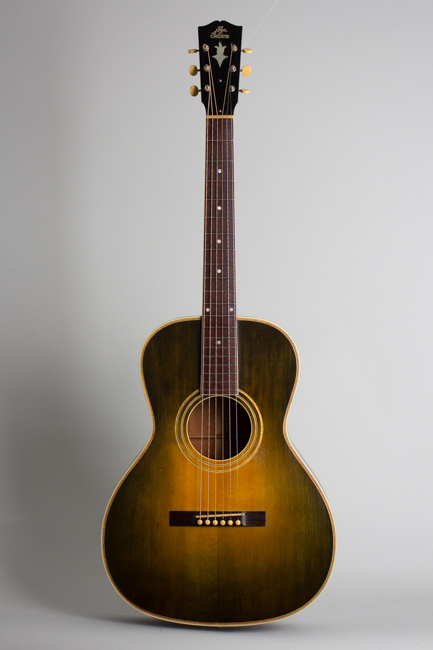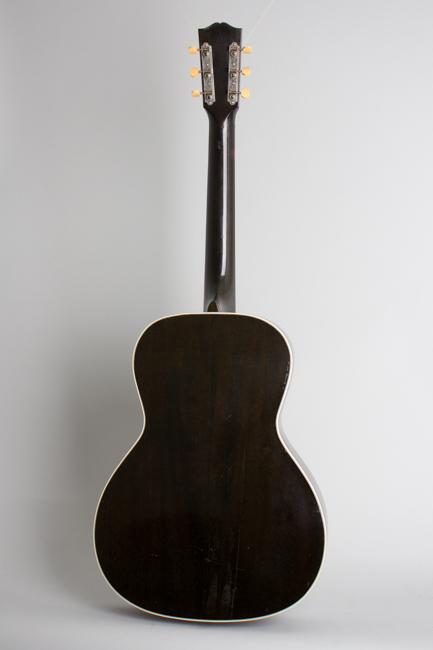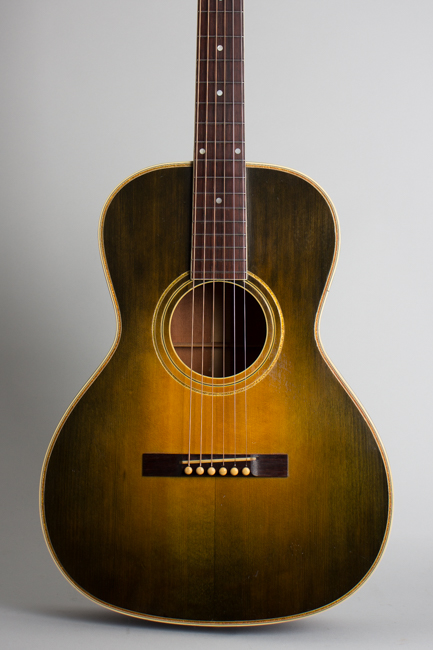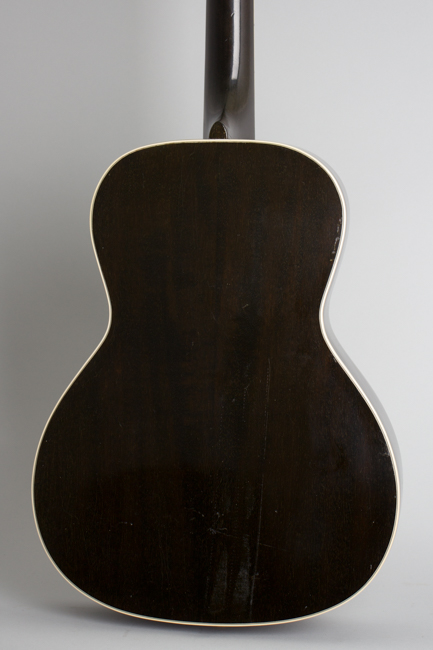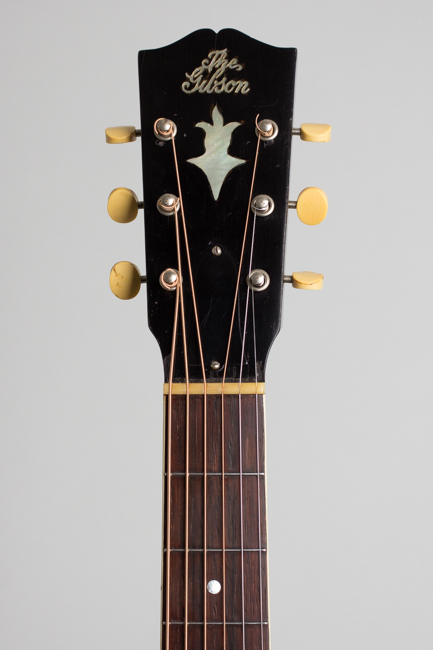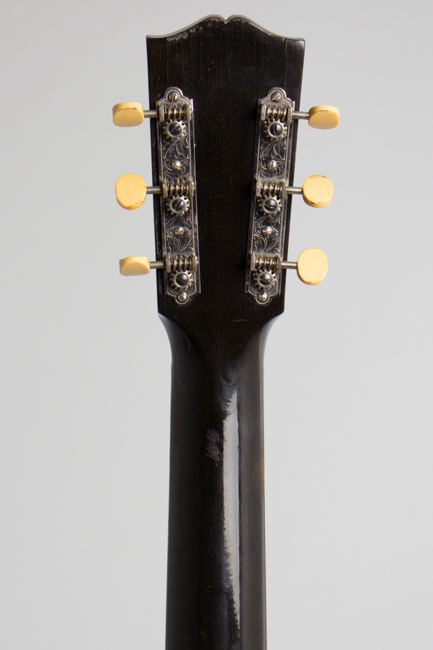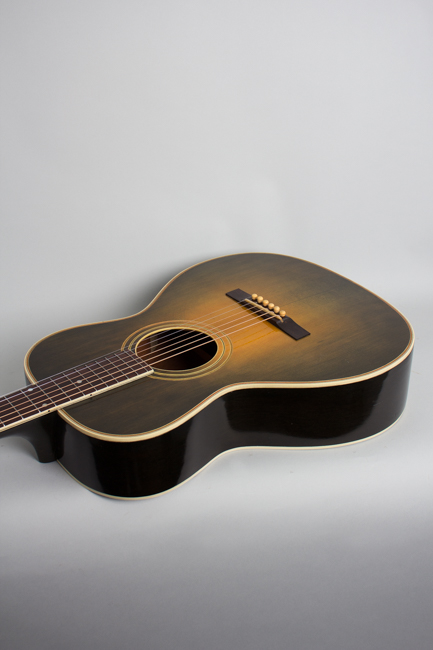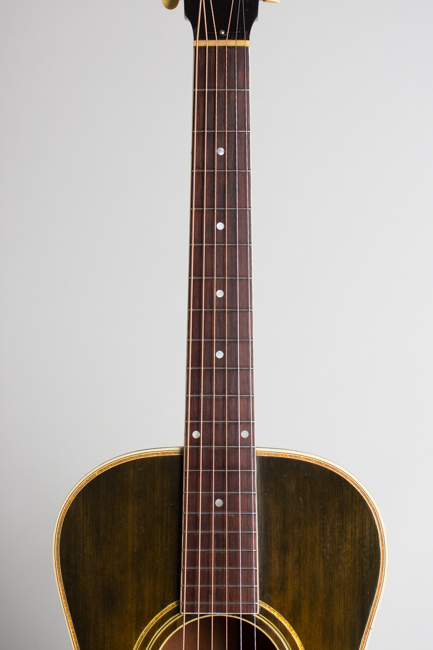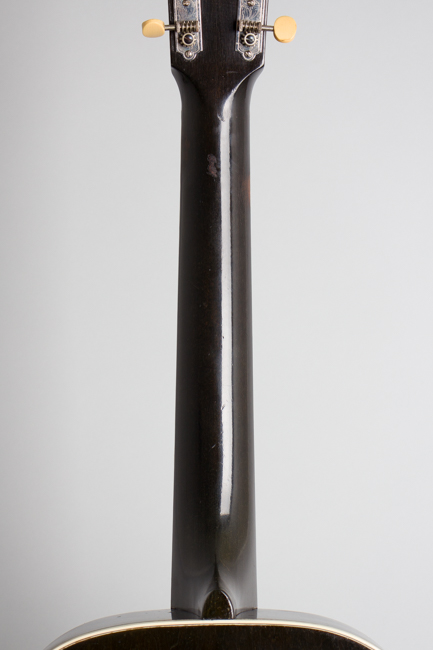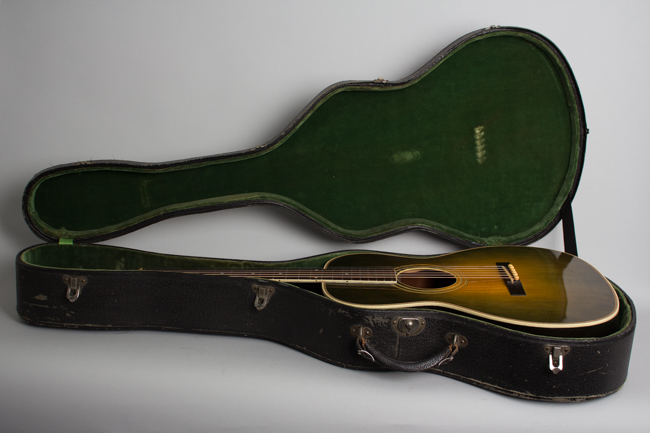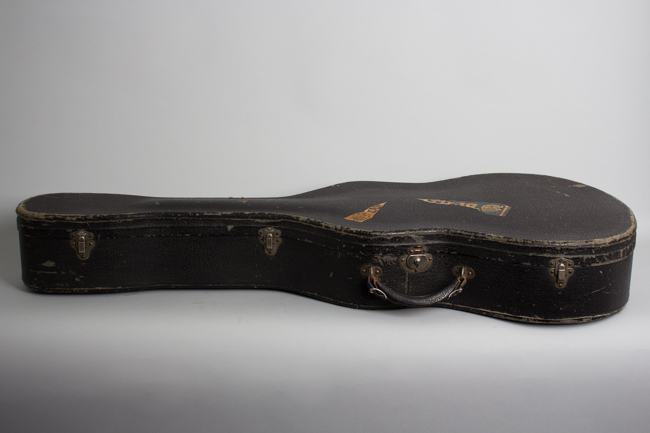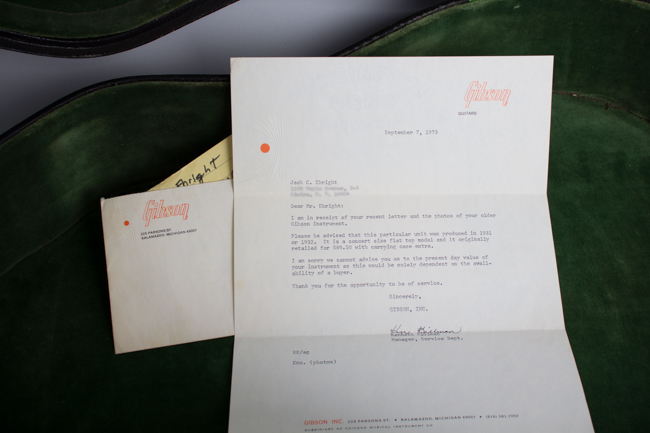Gibson L-2 Flat Top Acoustic Guitar (1930)
This item has been sold.
Item # 11215
Prices subject to change without notice.
Gibson L-2 Model Flat Top Acoustic Guitar (1930), made in Kalamazoo, Michigan, Argentine Grey top, dark mahogany back and sides finish, mahogany back and sides spruce top; mahogany neck with rosewood fingerboard, original black hard shell case.
Gibson minced no words in their 1930 catalog when describing this novel flat top: "A New Gibson Guitar Triumph! A challenging beauty setting a new high standard for modern guitar decoration...an instrument to command the center of attraction in any company...a swiftly rushing flow of golden tones...capped with foaming crests of flashing silvery notes...such is the new and incomparable voice of the L-2".
While Gibson's scribes may have been working overtime, this is truly spectacular guitar, a very rare and wonderful Gibson seldom seen in the 21st century. The flat-top L-2 in general is one of Gibson's more ephemeral creations, offered in a confusing array of woods, finishes and appointments over a brief period between 1929 and 1933. This 1930 version has a 12 fret neck and utterly distinctive cosmetics mixing features from earlier and later eras with some rather off-the-wall decorative touches to create a totally unique package. This L-2 has the elegant look of the 1920s Gibsons blinged up with some banjo flash all on the larger body of a "modern" 1930s flat-top guitar.
Over a short 3-4 year production life several different L-2 designs were issued, as if the company could not decide on a permanent design for a $75 flat top model, second only to the $125 Nick Lucas Special in the line. Some were rosewood, some mahogany, some had tailpieces, some pin bridges and the cosmetics varied seemingly with the wind. They did all share the then-new nearly 15" wide, less round-bottomed body introduced in 1929 replacing an earlier, smaller design. An X-braced spruce top was also consistent, first employed around 1928 on L-model flat tops. These features would continue to be used on large numbers 14-fret L-series guitars throughout the 1930s.
This early 1930 model neatly matches the Gibson catalog listing from that year. The body and neck are mahogany, the top is tight grained spruce. It features *exceptionally* light construction, even compared to other pre-war Gibsons like the common mid-1930s L-models. The X bracing is quite delicate, with thinner main braces than even Martin used at the time.
"The striking finish is an original tone of Argentine Grey, flecked with glints of gold allowing the natural pattern of the selected woods to penetrate through in a pleasing manner. Heavily inlaid with double lines of black and gold inlay." is how Gibson described the look. The top has a beautiful 1920s-style hand-rubbed sunburst finish in this new "Argentine Grey" shade which is in fact, neither. The fanciful name may be related to the Argentine Grey Fox, or just something someone at Gibson thought up! It IS a sort of greenish tint to the light sunburst; this one is both lighter and "greener' than others we have had. It was quite short-lived in 1930; Gibson revived it as an option at the end of the 1950's, also to minimal response.
Even more striking is the trim, a flashy gold sparkle celluloid inlaid around the top and soundhole. Oscar Schmidt offered Stellas with a similar look around this time; perhaps someone at Gibson saw one. An alternate theory is since Gibson had tried this on high-end banjos, someone suggested using a surplus to add some extra bling on a guitar. It proved another short-lived feature, but gives this L-2 a totally distinctive character. Multiple W/B/W binding on the body and single binding on the fingerboard and soundhole further dresses up the look.
The truss-rod equipped neck is very slim with a shallow round-backed "C" profile specific to this era, worlds away (and far more comfortably "modern' feeling) from the heavy "V" standard in the 1930s. The strings have noticeable taper towards the bridge making an ideal fingerpicking guitar. A pearl script "The Gibson" logo sits above a quizzical pearl inlay on the headstock, sometimes described as a flame, or a Jester's head; sort of a guitar Rorschach test. The tuners are strip Waverlys with engraved plates.
This L-2 was built in only very limited numbers, as a very expensive flattop released at the onset of the depression the market was pretty slim. Several other variants were offered over the next few years but this 1930 edition stands out as the most striking looking. It also happens to be a wonderful playing and sounding instrument, with VERY light construction throughout and a huge but engagingly sweet tone. The 1930 Gibson catalog was really not going too far afield in their colorful description; we love this model, and this is easily the nicest of them we have had
Overall length is 40 in. (101.6 cm.), 14 3/4 in. (37.5 cm.) wide at lower bout, and 4 3/8 in. (11.1 cm.) in depth at side, taken at the end block. Scale length is 24 3/4 in. (629 mm.). Width of nut is 1 3/4 in. (44 mm.).
This original 90+ year old L-2 is not *absolutely* pristine but as close as we have ever seen, just exceptionally well preserved for an early Gibson flat top. These 1930-era instruments are *very* lightly constructed and most survivors are heavily worn and/or rebuilt. This guitar remains completely intact, unaltered and an excellent player.
The all-original very thin lacquer finish shows little of the typical checking, mostly on the back. Overall the finish presents nicely with very good color and only minor dings, dents, scrapes and general handling wear. There are none of the heavy pick marks usually seen on older flat tops, just some minor scratches on the rim of and beneath the soundhole. The only real negative on the instrument is a decent size patch of "strap burn" on the back, into but not through the finish.
The very lightly built X-braced top is beautifully solid, with just some very slight arching behind the bridge. There are NO cracks to the thin top, back or sides, which is little short off extraordinary. The small rosewood bridge is original, with a few tiny spots of chipping around the perimeter where it was likely reglued. The thin maple bridgeplate is original and untouched. Internally everything remains original and untouched, including the beautiful very slim braces. The neck may have been reset but if so it is absolutely one of the cleanest jobs we have ever seen, and this is not an easy instrument to achieve that on!
The original tuners are intact including with shiny plates and the original composite white buttons, and still work well. The original thin wire frets show some very minimal wear in the lower positions and play fine. This guitar plays and sounds fantastic, superbly responsive with plenty of volume even when picked lightly and a powerful even tone. As early depression-era Gibson flat tops go this is a fantastic example of one of the most desirable of them all, a looker for sure but also a truly fine instrument. It is ready for another century still in the original green-lined HSC. Included is a really cool 1973 letter from Gibson, replying to an inquiry from the owner at the time as to its current value. Overall Excellent + Condition.
Gibson minced no words in their 1930 catalog when describing this novel flat top: "A New Gibson Guitar Triumph! A challenging beauty setting a new high standard for modern guitar decoration...an instrument to command the center of attraction in any company...a swiftly rushing flow of golden tones...capped with foaming crests of flashing silvery notes...such is the new and incomparable voice of the L-2".
While Gibson's scribes may have been working overtime, this is truly spectacular guitar, a very rare and wonderful Gibson seldom seen in the 21st century. The flat-top L-2 in general is one of Gibson's more ephemeral creations, offered in a confusing array of woods, finishes and appointments over a brief period between 1929 and 1933. This 1930 version has a 12 fret neck and utterly distinctive cosmetics mixing features from earlier and later eras with some rather off-the-wall decorative touches to create a totally unique package. This L-2 has the elegant look of the 1920s Gibsons blinged up with some banjo flash all on the larger body of a "modern" 1930s flat-top guitar.
Over a short 3-4 year production life several different L-2 designs were issued, as if the company could not decide on a permanent design for a $75 flat top model, second only to the $125 Nick Lucas Special in the line. Some were rosewood, some mahogany, some had tailpieces, some pin bridges and the cosmetics varied seemingly with the wind. They did all share the then-new nearly 15" wide, less round-bottomed body introduced in 1929 replacing an earlier, smaller design. An X-braced spruce top was also consistent, first employed around 1928 on L-model flat tops. These features would continue to be used on large numbers 14-fret L-series guitars throughout the 1930s.
This early 1930 model neatly matches the Gibson catalog listing from that year. The body and neck are mahogany, the top is tight grained spruce. It features *exceptionally* light construction, even compared to other pre-war Gibsons like the common mid-1930s L-models. The X bracing is quite delicate, with thinner main braces than even Martin used at the time.
"The striking finish is an original tone of Argentine Grey, flecked with glints of gold allowing the natural pattern of the selected woods to penetrate through in a pleasing manner. Heavily inlaid with double lines of black and gold inlay." is how Gibson described the look. The top has a beautiful 1920s-style hand-rubbed sunburst finish in this new "Argentine Grey" shade which is in fact, neither. The fanciful name may be related to the Argentine Grey Fox, or just something someone at Gibson thought up! It IS a sort of greenish tint to the light sunburst; this one is both lighter and "greener' than others we have had. It was quite short-lived in 1930; Gibson revived it as an option at the end of the 1950's, also to minimal response.
Even more striking is the trim, a flashy gold sparkle celluloid inlaid around the top and soundhole. Oscar Schmidt offered Stellas with a similar look around this time; perhaps someone at Gibson saw one. An alternate theory is since Gibson had tried this on high-end banjos, someone suggested using a surplus to add some extra bling on a guitar. It proved another short-lived feature, but gives this L-2 a totally distinctive character. Multiple W/B/W binding on the body and single binding on the fingerboard and soundhole further dresses up the look.
The truss-rod equipped neck is very slim with a shallow round-backed "C" profile specific to this era, worlds away (and far more comfortably "modern' feeling) from the heavy "V" standard in the 1930s. The strings have noticeable taper towards the bridge making an ideal fingerpicking guitar. A pearl script "The Gibson" logo sits above a quizzical pearl inlay on the headstock, sometimes described as a flame, or a Jester's head; sort of a guitar Rorschach test. The tuners are strip Waverlys with engraved plates.
This L-2 was built in only very limited numbers, as a very expensive flattop released at the onset of the depression the market was pretty slim. Several other variants were offered over the next few years but this 1930 edition stands out as the most striking looking. It also happens to be a wonderful playing and sounding instrument, with VERY light construction throughout and a huge but engagingly sweet tone. The 1930 Gibson catalog was really not going too far afield in their colorful description; we love this model, and this is easily the nicest of them we have had
Overall length is 40 in. (101.6 cm.), 14 3/4 in. (37.5 cm.) wide at lower bout, and 4 3/8 in. (11.1 cm.) in depth at side, taken at the end block. Scale length is 24 3/4 in. (629 mm.). Width of nut is 1 3/4 in. (44 mm.).
This original 90+ year old L-2 is not *absolutely* pristine but as close as we have ever seen, just exceptionally well preserved for an early Gibson flat top. These 1930-era instruments are *very* lightly constructed and most survivors are heavily worn and/or rebuilt. This guitar remains completely intact, unaltered and an excellent player.
The all-original very thin lacquer finish shows little of the typical checking, mostly on the back. Overall the finish presents nicely with very good color and only minor dings, dents, scrapes and general handling wear. There are none of the heavy pick marks usually seen on older flat tops, just some minor scratches on the rim of and beneath the soundhole. The only real negative on the instrument is a decent size patch of "strap burn" on the back, into but not through the finish.
The very lightly built X-braced top is beautifully solid, with just some very slight arching behind the bridge. There are NO cracks to the thin top, back or sides, which is little short off extraordinary. The small rosewood bridge is original, with a few tiny spots of chipping around the perimeter where it was likely reglued. The thin maple bridgeplate is original and untouched. Internally everything remains original and untouched, including the beautiful very slim braces. The neck may have been reset but if so it is absolutely one of the cleanest jobs we have ever seen, and this is not an easy instrument to achieve that on!
The original tuners are intact including with shiny plates and the original composite white buttons, and still work well. The original thin wire frets show some very minimal wear in the lower positions and play fine. This guitar plays and sounds fantastic, superbly responsive with plenty of volume even when picked lightly and a powerful even tone. As early depression-era Gibson flat tops go this is a fantastic example of one of the most desirable of them all, a looker for sure but also a truly fine instrument. It is ready for another century still in the original green-lined HSC. Included is a really cool 1973 letter from Gibson, replying to an inquiry from the owner at the time as to its current value. Overall Excellent + Condition.
